|
TOURIST PLACE IN
TRIPURA
The best season for
touring in Tripura is October to March. Those who wants to enjoy the rain may
travel in the months of June to August. Mode of reaching to Tripura: There
are three ways to reach to Tripura. First is by Road ways. From Guwahati via
Shilong one can reach to Agartala, the state capital and main business center.
Second mode is to travel by Indian Rail ways from Guwahati up to
Dharmanagar-Kumarghat. From there by road up to Agartala.
Third means of
commuting is by Indian air lines. There are two approaches one is from Kolkata
to Agartala and another is through Guwahati to Agartala. The flight fare is
subsidized like most of the North-Eastern states. Air lines like Air India,
Deccan, Kingfisher, Indigo, Jet Air, etc are flying every day with day above
destination.
For information and Reservation
the contact address:
Tourism wing, information, cultural affairs and
tourism Department, Swet Mohol.
Agartala, Tel : (0381) 22-5930/22-3893
Fax : 0381-32-5823
Important tourist destination:
Agartala:
Once a good hunting ground, Agartala became the capital of the state during the
time of Maharaja Krishnakishore Manikya (1830-50). It has remained since then
the seat of the state headquarters. A few places of interest in and around the
town are: It is the biggest
town and business center and the capital of the state of Tripura. the town is
very beautiful and well planned. It is called Aguli by the Tripuris. The present
Agartala was founded as the new capital of Tripura in the year 1844 by the king
Maharaj Krishno Kishore Manikya from its earlier place of Old Agartala, which is
located in the East and south bank of the rive Saidra(Howra). The palace of
Manikya dynasty of royal of Tripura, the Ujjayanta Palace is one of the most
beautiful palace of the than princely states of India though the palace is not
so big as compare to other palaces. The palace was built in the year 1899 by the
king of Tripura Radhakishore Manikya Bahadur. The architect of the palace was
Sir Alexander Martin and built by Messer's
Martin &co. The Centenary Celebration of the Ujjayanta palace had been
organized in the year 2001 from January the 26th –30th.
Ujjayanta Palace:
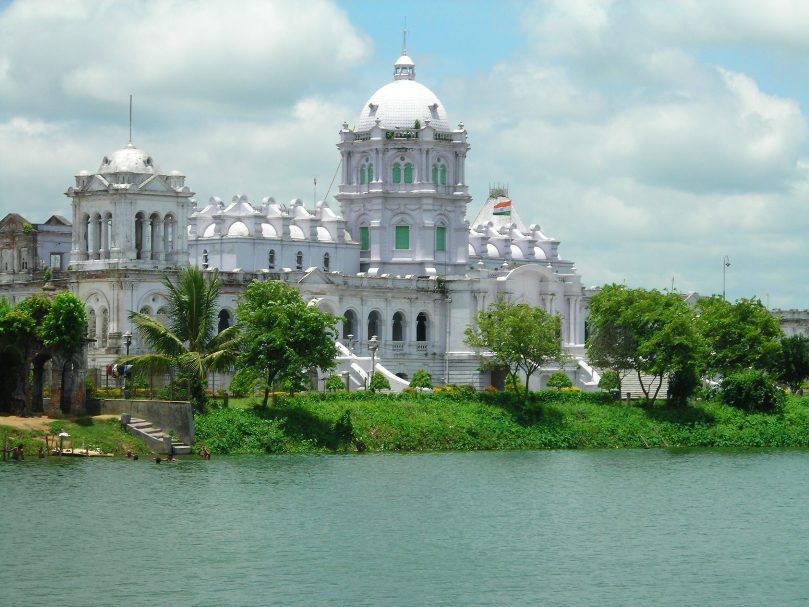 Situated in the heart of the town and covering an area of about half a square
mile this palace is a two-storied mansion having a mixed architecture with three
domes, the central one being 86 feet high. The construction of this beautiful,
well-balanced royal palace was undertaken in 1899 and completed in 1901 at a
cost of a little over Rs 10 lakhs. The two large tanks on two sides with the
approach road in between them and the well-laid out gardens around the palace
with water courses and fountains patterned on the Mughal gardens have added
beauty to it. The main block of the palace covers about 80 acres and contains
halls like the Throne Room, the Durbar Hall, Library, Study, the Reception Hall,
etc. which were furnished with objects of art, curios, chandeliers, etc. A few
old manuscripts, books, artistic hand I crafts, musical instruments and some old
armouries like (lie historical sword presented to Govinda Manikya by Sultan Suja
were some of the many collections that were once on display in different rooms
of the palace. A few more blocks, viz., Swet Mahal used as the guest-house, the
Banquet Hall, Lal Mahal etc. were subsequently constructed. The palace has been
acquired by the state government and now houses the Legislative Assembly,
besides a few government offices. This is going to be made states national
museum as per the agreement by ATTF, when Assembly hall would be shifted to new
Assembly hall being constructed at new capital complex in Khejur bagan. Situated in the heart of the town and covering an area of about half a square
mile this palace is a two-storied mansion having a mixed architecture with three
domes, the central one being 86 feet high. The construction of this beautiful,
well-balanced royal palace was undertaken in 1899 and completed in 1901 at a
cost of a little over Rs 10 lakhs. The two large tanks on two sides with the
approach road in between them and the well-laid out gardens around the palace
with water courses and fountains patterned on the Mughal gardens have added
beauty to it. The main block of the palace covers about 80 acres and contains
halls like the Throne Room, the Durbar Hall, Library, Study, the Reception Hall,
etc. which were furnished with objects of art, curios, chandeliers, etc. A few
old manuscripts, books, artistic hand I crafts, musical instruments and some old
armouries like (lie historical sword presented to Govinda Manikya by Sultan Suja
were some of the many collections that were once on display in different rooms
of the palace. A few more blocks, viz., Swet Mahal used as the guest-house, the
Banquet Hall, Lal Mahal etc. were subsequently constructed. The palace has been
acquired by the state government and now houses the Legislative Assembly,
besides a few government offices. This is going to be made states national
museum as per the agreement by ATTF, when Assembly hall would be shifted to new
Assembly hall being constructed at new capital complex in Khejur bagan.
It has a great architectural assimilation of
Greek, Roman, and Mogul style. It bears the Royal history Tripura, witnesses its
glorious heritage.
Kunjaban Palace:
 Within a mile of the Ujjayanta Palace and
to the north stands a picturesque hillock known as Kunjaban. The palace there
was built by Maharaja Birendrakishore Manikya (1909-23) who was a good artist
and is said to have prepared himself the plan of the palace and the adjoining
gardens. The spot-also selected by the Maharaja himself-was considered ideal for
relaxation and pleasure strolls in those days. The palace constructed there was
used as such, viz., for retreats and relaxation of the Maharajas and their
guests. Rabindranath during his seventh and last visit to Agartala in 1926
stayed in the eastern apartment of this palace. One could get a distant view of
the Baramura Hills on the eastern horizon from the round verandah, attached to
this eastern part. This verandah has been the site where from a few popular
songs (all incorporated in the Vaikali series) have been composed. The palace
has since been taken over by the state government, and is now used as the
official residence of the Governor of the state. Kunjavan Palace,
the palace is situated in the North side
of the city in a small hillock. It is ovular shaped and it is housing at present
the Governor of Tripura, it is also beautiful palace, on the East side of the
palace is the famous Malancha Nivas. There
are under ground rooms also in the Nivas. Within a mile of the Ujjayanta Palace and
to the north stands a picturesque hillock known as Kunjaban. The palace there
was built by Maharaja Birendrakishore Manikya (1909-23) who was a good artist
and is said to have prepared himself the plan of the palace and the adjoining
gardens. The spot-also selected by the Maharaja himself-was considered ideal for
relaxation and pleasure strolls in those days. The palace constructed there was
used as such, viz., for retreats and relaxation of the Maharajas and their
guests. Rabindranath during his seventh and last visit to Agartala in 1926
stayed in the eastern apartment of this palace. One could get a distant view of
the Baramura Hills on the eastern horizon from the round verandah, attached to
this eastern part. This verandah has been the site where from a few popular
songs (all incorporated in the Vaikali series) have been composed. The palace
has since been taken over by the state government, and is now used as the
official residence of the Governor of the state. Kunjavan Palace,
the palace is situated in the North side
of the city in a small hillock. It is ovular shaped and it is housing at present
the Governor of Tripura, it is also beautiful palace, on the East side of the
palace is the famous Malancha Nivas. There
are under ground rooms also in the Nivas.
Malancha Nivas:
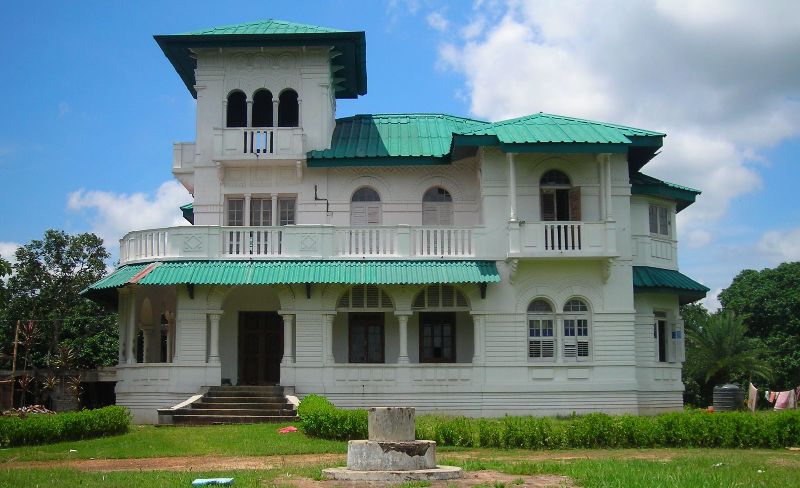 This
was a luxury resort cum rest house of the Manikya Dynasty, the Tripuri Kings.
This is situated in the north-east side of Kunjavan palace. This nivas or resort
have under ground tunnel surrounding it and the exit point of it is towards the
east of the building for the safe escape in case of emergency. This was also
used as the guest house for the royal guests. Famous poet of Bengal and
philosopher Rabindra Nath Tagore visited six times in Tripura during his life
time, more than any states or place ever visited by Gurudev. When he visited the
state, it was this lonely isolated palace where he used to stay, as its serene
beauty was utmost conducive atmosphere for creating various literary works. This
was a luxury resort cum rest house of the Manikya Dynasty, the Tripuri Kings.
This is situated in the north-east side of Kunjavan palace. This nivas or resort
have under ground tunnel surrounding it and the exit point of it is towards the
east of the building for the safe escape in case of emergency. This was also
used as the guest house for the royal guests. Famous poet of Bengal and
philosopher Rabindra Nath Tagore visited six times in Tripura during his life
time, more than any states or place ever visited by Gurudev. When he visited the
state, it was this lonely isolated palace where he used to stay, as its serene
beauty was utmost conducive atmosphere for creating various literary works.
Jagannath
Temple:
Situated near Kunjaban palace, the temple
not only attracts the Hindus, but also many others because of its peculiar
structure which is octagonal at the basement, and has an excellent
pradakshinapatha round the sanctum. "Every pillar of the octagon is crowned by a
square pyramidal cone rising above a multifoil niche which comes at the level of
the terrace. The Sikhara is a stepped octagonal pyramid rising in four storeys
above the vertical portion over the terrace. An elevation like this reminds one
of a steeple which would throw down snow whenever it fell. A construction like
this would perhaps suggest a snowy Himalayan origin, as in these parts it would
have no meaning in the physical environment."
Among
other places of interest in and around Agartala, mention may be made of the
Maharaja Bir Bikram College campus, the Government Museum, the Craft Teachers'
Training Institute, and the Rabindra Satabarshiki Bhavan.
Other important land marks for the tourist are the
state Museum,
situated in the center of the city. It contains the many archeological findings
of Tripura, the Royal belongings, dresses & uniforms, weapon, coins, and many
other worth seeing.
The
M.B.B. College,
founded by the last but one King of Tripura, Maharaja Bir Bikrom Kishore Manikya
Bahadur. It is the biggest college of the state, located in the south part of
the city, in the hillock. It is very beautiful and well maintained. It has all
the discipline and post graduate courses.
Old or Puran
Agartala:
It was the capital of Tripura since the time of Maharaja Krishna Manikya
(1760-83) who shifted the capital from Udaipur to this place in the face of
continued hostility with Samsher Gazi who attacked Udaipur in 1748. One,
therefore, still witnesses the ruins of the old palace of the rajas and some
Mathas erected on the pyres of the members of the royal family.
Chaturdasa Devata
Mandir at Old Agartala :
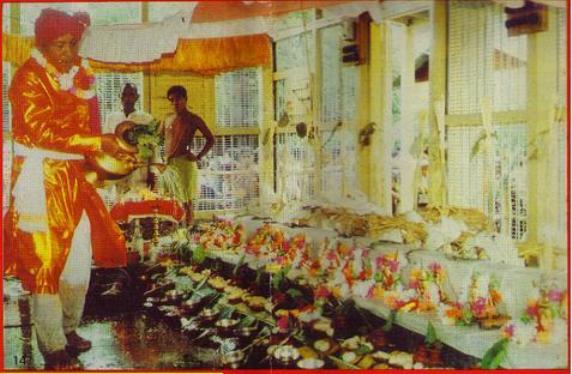 The temple (popularly called Chaudda Devata Mandir) situated at a distance of
about 8 km from Agartala town houses the fourteen god-heads identified with
Siva, Durga, Han or Vishnu, Ma or Lakshmi, Vani or Saraswati, Kumar or Kartikeya,
Ganapa or Ganesha, Brahma, Prithivi, Abdhi or Samudra, Ganga, Sikhi or Agni,
Kamadeva and Himadri. They are regarded as the presiding deities of the royal
house and worshipped by the Cantais, the priests of the Tripuris. But, in fact,
the Chaudda Devata or fourteen gods have now become the presiding deities of the
local people, including the immigrants. Thousands of pilgrims visit the temple
each year on the occasion of Kharchi puja which usually falls in the month of
Ashada (June-July), It is situated in old
Agartala, the past capital of the state. Every year during the month of
June-July the 'Kharchi' puja is celebrated in this temple. Lacks of people both
Tripuris and non-Tripuris alike gather here to do puja and offerings. It is one
of the festival which though is of Tripuris but had been turned as true Tripura
festival. The fourteen Gods are worshipped during these seven days. Many
He-goats ship, buffalo etc are offered here to the gods. The temple (popularly called Chaudda Devata Mandir) situated at a distance of
about 8 km from Agartala town houses the fourteen god-heads identified with
Siva, Durga, Han or Vishnu, Ma or Lakshmi, Vani or Saraswati, Kumar or Kartikeya,
Ganapa or Ganesha, Brahma, Prithivi, Abdhi or Samudra, Ganga, Sikhi or Agni,
Kamadeva and Himadri. They are regarded as the presiding deities of the royal
house and worshipped by the Cantais, the priests of the Tripuris. But, in fact,
the Chaudda Devata or fourteen gods have now become the presiding deities of the
local people, including the immigrants. Thousands of pilgrims visit the temple
each year on the occasion of Kharchi puja which usually falls in the month of
Ashada (June-July), It is situated in old
Agartala, the past capital of the state. Every year during the month of
June-July the 'Kharchi' puja is celebrated in this temple. Lacks of people both
Tripuris and non-Tripuris alike gather here to do puja and offerings. It is one
of the festival which though is of Tripuris but had been turned as true Tripura
festival. The fourteen Gods are worshipped during these seven days. Many
He-goats ship, buffalo etc are offered here to the gods.
Go to Top
Shipahijola Forest
Resort:
Half-an-hour drive from Agartala through an attractive forest, flowerage
greenery and rubber plantation, the area now serves as a beautiful picnic spot.
It holds various animals and birds, rare snakes, and big lakes around the animal
sanctuary. This is a wild life sanctuary and
beautiful picnic and tourist spot. There is also a lake surrounded by hills on
both sides. This is about 22 km. from Agartala.
Brhmakunda:
It is about 48 km north of Agartala on way
to Simna, the place has acquired prominence both as a holy place as well as
tourist spot. A Shiva temple and a holy pool where devotees take their sacred
bath are the two main centres of attraction. Besides Melas (fairs) held twice in
a year, usually in April and November add further attraction to a large number
of faithftils. On either side of the road leading to Brhmakunda lies the vast
stretch of tea gardens adding a splash of greenery and making the road journey
delightful and captivating.
Tirtharnukh:
Dombur:
 In Amarpur subdivision, Tirthamukha is so-called as it is near the Dumbur falls
which is the source of the river Gomati- considered as the most holy river by
the Tripuri. Every year thousands of pilgrims visit the place-about 117 km away
from Agartala-on the occasion of Uttarayan Sankranti for a holy dip. A mela is
held on this occasion, and the Tripuri make their annual purchases there.
It is an important tourist and religious place of
Tripura. there is a water fall called in the above name. Every year in the month
of mid- January a fair is organized in this site for seven conteneous days. The
Tripuis of all clans gather here to pay their last respect to their departed
near and dear ones in the 'Hangrai' day which fall arround on 14th of
January. The evening are full of cultural programmes which lasts through out the
nights. There is also dam at Dombur hydroelectric power, a boating is a popular
attraction for the tourists.A hydro-electric power generating
station has been set up there. Its reservoir-about 40 sq. km in size-is dotted
with mini islands where coconut, orange, pine apple and lichi plants add beauty
to them. It is enchanting to take voyage and go down for a while to the lake in
boats in a moonlit night or in the evening. A tourist lodge has been built in
the area. In Amarpur subdivision, Tirthamukha is so-called as it is near the Dumbur falls
which is the source of the river Gomati- considered as the most holy river by
the Tripuri. Every year thousands of pilgrims visit the place-about 117 km away
from Agartala-on the occasion of Uttarayan Sankranti for a holy dip. A mela is
held on this occasion, and the Tripuri make their annual purchases there.
It is an important tourist and religious place of
Tripura. there is a water fall called in the above name. Every year in the month
of mid- January a fair is organized in this site for seven conteneous days. The
Tripuis of all clans gather here to pay their last respect to their departed
near and dear ones in the 'Hangrai' day which fall arround on 14th of
January. The evening are full of cultural programmes which lasts through out the
nights. There is also dam at Dombur hydroelectric power, a boating is a popular
attraction for the tourists.A hydro-electric power generating
station has been set up there. Its reservoir-about 40 sq. km in size-is dotted
with mini islands where coconut, orange, pine apple and lichi plants add beauty
to them. It is enchanting to take voyage and go down for a while to the lake in
boats in a moonlit night or in the evening. A tourist lodge has been built in
the area.
Go to Top
Jampui Hill:
Conspicuous for its highest peak Belting Sib and spread over in thick green
undulations, Jampui Hill is better known for its enchanting landscape and
bracing climate. To its north is Sylhet (in Bangladesh) and to the south lies
the Langten range of Chittagong (also in Bangladesh). Jampui range stands as the
natural boundary between the two adjoining states of Tripura and Mizoram.
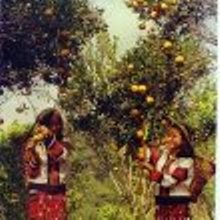 The inhabitants of the hill are
Riang subtribes of Tripuri people, Sikams
who have settled there in ten villages, namely, Fuldang Sai, Chhabwal, Tiang
Sang, Bangla Ban, Behhang Chhip, Vanghmun, Tlakshi, Hmunpui, Hmung huang and
Bhai Sum. These villages are situated at different heights on the hill. Graceful
and hospitable the Mizos are fairly educated (compared to other tribes of the
state) and arc mostly Christians. Good quality oranges are grown here and they
are in high demand for their taste and juice. Two important markets in the area
are Kanchanpur and Dasda Bazar. From the latter the foothill is about 10 km and
Agartala is 218 km. For its charming landscape and invigorating climate the area
has earned the distinction of becoming one of the few tourist spots in the
state. The view of the landscape from its peak looks exceedingly beautiful. The
famous bamboo dance of the Mizos breaks the monotony of a humdrum life and
lends warmth, colour and vigour to it. The inhabitants of the hill are
Riang subtribes of Tripuri people, Sikams
who have settled there in ten villages, namely, Fuldang Sai, Chhabwal, Tiang
Sang, Bangla Ban, Behhang Chhip, Vanghmun, Tlakshi, Hmunpui, Hmung huang and
Bhai Sum. These villages are situated at different heights on the hill. Graceful
and hospitable the Mizos are fairly educated (compared to other tribes of the
state) and arc mostly Christians. Good quality oranges are grown here and they
are in high demand for their taste and juice. Two important markets in the area
are Kanchanpur and Dasda Bazar. From the latter the foothill is about 10 km and
Agartala is 218 km. For its charming landscape and invigorating climate the area
has earned the distinction of becoming one of the few tourist spots in the
state. The view of the landscape from its peak looks exceedingly beautiful. The
famous bamboo dance of the Mizos breaks the monotony of a humdrum life and
lends warmth, colour and vigour to it.
The
Betling Sib is the
highest peak in Tripura and situated in the Jampui hill. There is a temple
of Siva once constructed by, Jhujharufa, Kings of Tripura some 1400 years back.
It is a Linga, considered as Holy by the Tripuri people.
Pancharthal:
Developing fast as an important local market for jhum products as well as for
Jampui oranges, Pancharthal is located on the Assam-Agartala road at a distance
of about 128 km away from Agartala town. An important attraction to the visitor
is a big-sized brass image of Lord Buddha in sitting posture.
Unakoti Tirtha:
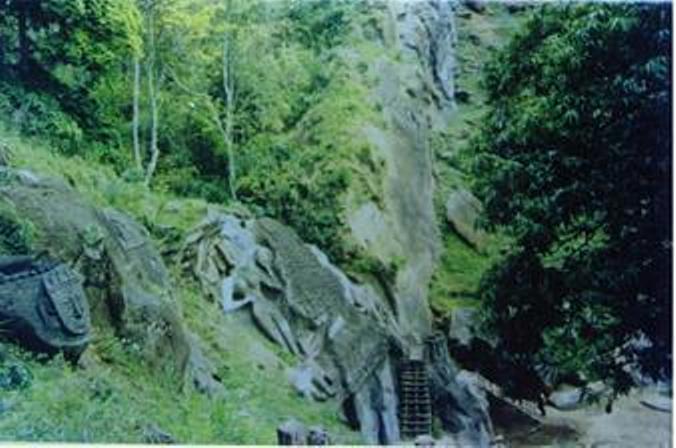 Situated at a distance of about 177 km from Agartala and about five miles from
Kailasahar, sub-divisional headquarter of the state, this holy shrine in the
hilly part nestles in the lap of picturesque hills with an unending spell of
luxuriant green vegetation around it. In its rocky walls are found numerous
rock-cut images scattered on either side of the hill track. "Among the rock-cut
figures, the Central Siva head and the gigantic Ganesa figures deserve special
mention. The Central Siva head, known as Unakotisvara Kal Bhairava is about 30
feet high, including the embroidered head dress, which is 10 feet in height.
Three enormous images of a bull are found half-buried in the ground. On each
side of the head-dress of the Central Siva, there were two full-sized female
figures. The figure of Durga standing on a lion and another female figure are
found carved on the rocky wall above. Two other gigantic heads of Siva and Durga
attract notice if one stands on the terminus of the new road leading to Unakoti.
Among the images, particular mention of two Chaturmukha and one Trimukha lingas,
the former found on the bank of the stream and the latter at some height on the
hill, may be made for their fine execution. At the top of hill images of Vishnu,
Panchamukha, Ravana, Hara-Gouri, Narasingha, seated Ganesa, Hanumana etc. are
found. Situated at a distance of about 177 km from Agartala and about five miles from
Kailasahar, sub-divisional headquarter of the state, this holy shrine in the
hilly part nestles in the lap of picturesque hills with an unending spell of
luxuriant green vegetation around it. In its rocky walls are found numerous
rock-cut images scattered on either side of the hill track. "Among the rock-cut
figures, the Central Siva head and the gigantic Ganesa figures deserve special
mention. The Central Siva head, known as Unakotisvara Kal Bhairava is about 30
feet high, including the embroidered head dress, which is 10 feet in height.
Three enormous images of a bull are found half-buried in the ground. On each
side of the head-dress of the Central Siva, there were two full-sized female
figures. The figure of Durga standing on a lion and another female figure are
found carved on the rocky wall above. Two other gigantic heads of Siva and Durga
attract notice if one stands on the terminus of the new road leading to Unakoti.
Among the images, particular mention of two Chaturmukha and one Trimukha lingas,
the former found on the bank of the stream and the latter at some height on the
hill, may be made for their fine execution. At the top of hill images of Vishnu,
Panchamukha, Ravana, Hara-Gouri, Narasingha, seated Ganesa, Hanumana etc. are
found.
Archaeologists maintain that these
images may be dated sometime not earlier than the llth-l2th centuries. Many more
images are, however, yet to be identified. A big mela (fair)-popularly known as
"Ashokastami Mela" is held every year at Unakoti sometime in spring. Thousands
of pilgrims gather to offer Puja at this tirtha which is considered one of the
most sacred pilgrim centres in Eastern India.
Go to Top
Nirmahal:
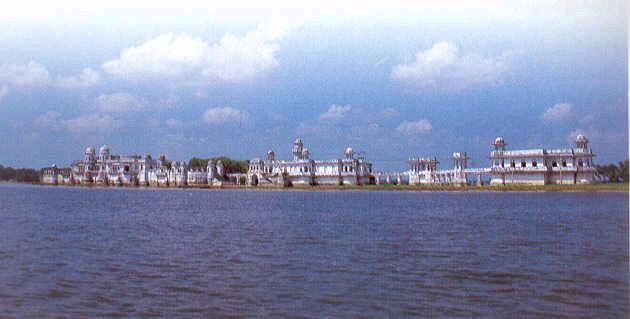 One of the finest beauty spots of the state, this once-beautiful lake is
situated at distance of about 53km from Agartala.
The palace is
situated in the mid of a big lake called Rudra
Sagar.
To approach the palace one has to ferry by boat. There is a state tourist lodge
named 'Sagar Mahal',
situated in the East bank of the Rudro Sagor, facing the palace. The palace and
the lake is worth seeing and visiting. Night halt and spent on the site is
desirable. The rent of the guest house is affordable.
The palace is so called as it
is surrounded on all sides by a big lake called Rudra Sagar. The scenic beauty
of the lake attracted Bir Bikramkishore Manikya (1927-47) so much that he built
a spectacular palace at the centre of the lake itself and named it as Nirmahal
(or palace in water). Although the building is now in a dilapidated condition
and requires immediate renovation if the area is to serve as an important
tourist spot, even today the place looks attractive particularly on a moonlit
night. The vast stretch of the lake reflects light which make it feel of dream
land. Neermahal,
Literally 'neermahal' means 'palace in water' or
'floating palace' and it is also one of the Tripura's Royal Heritage. Situated
in the town of Melaghor, about 55 km. from Agartala. The palace was built by
king Moharaja Bir Bikrom Kishore Manikyo Bahadur in 1939 A.D. It is 400 meter
long palace and has 24 rooms. The palace was used as summer resort by the King
Bir Bikrom. One of the finest beauty spots of the state, this once-beautiful lake is
situated at distance of about 53km from Agartala.
The palace is
situated in the mid of a big lake called Rudra
Sagar.
To approach the palace one has to ferry by boat. There is a state tourist lodge
named 'Sagar Mahal',
situated in the East bank of the Rudro Sagor, facing the palace. The palace and
the lake is worth seeing and visiting. Night halt and spent on the site is
desirable. The rent of the guest house is affordable.
The palace is so called as it
is surrounded on all sides by a big lake called Rudra Sagar. The scenic beauty
of the lake attracted Bir Bikramkishore Manikya (1927-47) so much that he built
a spectacular palace at the centre of the lake itself and named it as Nirmahal
(or palace in water). Although the building is now in a dilapidated condition
and requires immediate renovation if the area is to serve as an important
tourist spot, even today the place looks attractive particularly on a moonlit
night. The vast stretch of the lake reflects light which make it feel of dream
land. Neermahal,
Literally 'neermahal' means 'palace in water' or
'floating palace' and it is also one of the Tripura's Royal Heritage. Situated
in the town of Melaghor, about 55 km. from Agartala. The palace was built by
king Moharaja Bir Bikrom Kishore Manikyo Bahadur in 1939 A.D. It is 400 meter
long palace and has 24 rooms. The palace was used as summer resort by the King
Bir Bikrom.
UDAIPUR
It
was the capital of Tripura for more than a millennium. It has lost its
significance as the capital when the capital of Tripura was shifted to old
Agatala by Maharaj Krishna Manikya about 240 years ago. The old name of Udaipur
was Rangamati, which was changed to Udaipur by king Udai Manikya by his name.
The most important
site of the city is
Tripura Sundari Temple.
The significance of the temple is both religious and historical. It has been
accounted as pilgrimage by the people of Tripura, had become a popular tourist
attraction. The deity of the temple is Kali considered as one of the 51
pithas . The Tripuris called the deity as Ama. As per Hindu mythology, it is
considered that the left leg of Kali fell at the site of the temple. Maharaj
Dhonya Manikya built the temple in 1501A.D. There is a big pond 'Kalyansagar' on
the East side of the temple.
There are many
ruined buildings, palaces, temples, lakes, scattered all arround the city. Some
of the ruins of the palaces were of Chharta Manikya or Nakshatra Manikya,
Udai Manikya, and Hirapur. Some of the important temples are Mohadev bari,
Gopinath temple, Vishnu temple, Jagannath bari, Hari mandir, Nager dol, Dutyar
bari, Bhuvaneshwar temple, Gunabati temple, temple of fourteen gods. A fair
number of the temple are in extinct, some are worn out conditions.
The history of the Udaipur
will remain incomplete unless the ponds are mentioned. It would not be over
emphasized if Udoipur is termed as Lake town. Some of the important ponds are
Amor Sagor, Dhonya sagor, Jagannath Dighi, Bijoy Sagor, Chondro Sagor, Chhotro
Sagor, Kolyansagor, Buria, Dhormo Sagor, Ram Sagor, Mohendro Sagor, Nanuar
Sagor. Apart from these there are many small and medium sixe ponds still bearing
the testimony of the golden Royal history of Tripura of Manikya Dynasty. Some
of them to name are Kumari Dhepa, Sotyo Nazirer Dighi, Maighya Dighi, Tal
Puskuruni, Chontai Dighi, to name a few. Many of the ponds may have extinct
today by the passage of time and unauthorised human occupation.
Since Udaipur was capital
town of Tripura for a long time, many temples had been built there at various
intervals in the past. On account of numbers there is no other town in Tripura
consisting of so many temples. So, quite obviously Udaipur is also referred to
as the Town of Temples'.
Wasn't there any temple at
Udaipur prior to the Tripura Sundari Temple? Such a curiosity is quite natural.
Because, Udaipur (formerly Rangamati)* came up as the capital 911 years before
the temple was built. In this intermediary period many rulers had governed the
state and there must have been temple for worship too, but no such evidences
have been found. Though in the contrary, many evidences in the form of coins
have been discovered that bear the testimony that the rulers of Tripura had
always been very religious. Few Brahmins said to have come from Bengal during
the reign of Ratna Manikya-I (according to Rajmala). But now one won't find a
single temple of that era. Many historical evidences are at hand that testitj
that Chaturdash Devta had been worshipped for many years in the state, but there
is no existence of such an old Chaturdash Devta temple at Udaipur.
But, one must admit that only
from the time of Dhanya Manikya, a new trend has been set in the history of
temple construction. Thereafter, many more temples and places of worship had
been raised by rulers at different period. Out of those, some are completely
ruined and some are in dilapidated condition. Probably, few have become extinct
in course of time. Nevertheless, it is true that the present day temples at
Udaipur belong to the time of Dhanya Manikya and his successors.
In 1464 AD. Maharaja Ratna
Manikya renamed the capital Rangamati' to 'Ratnapur'. In 1567 AD., Suba Gopi
Prasad endorsing the name Udai Manikya, ascended the throne and changed the name
Ratnapur to 'Udaipur'. History of 'Udaipur' spans 434 years. and before that 'Ratnapur'
had a history of 104 years. But even before that Rangamati' had a very old
history.
Tripurasundari
Temple (Udaipur):
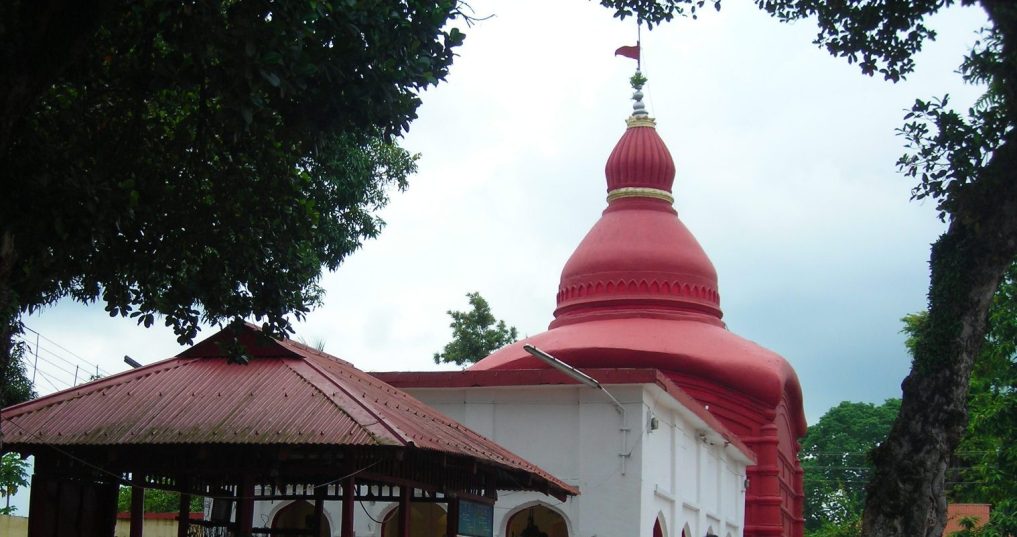 The temple is considered to be one of the oldest Pithasthan,
Tripurasundari temple at Udaipur consists of a square type sanctum of the
typical Tripuri-hut-type above which rises a conical dome with a continuous
series of low niches at the base simulating lotus leaves. On this rises the
amalaka which has been made elongated in order to conform to the shape of a
cone. The temple is considered to be one of the oldest Pithasthan,
Tripurasundari temple at Udaipur consists of a square type sanctum of the
typical Tripuri-hut-type above which rises a conical dome with a continuous
series of low niches at the base simulating lotus leaves. On this rises the
amalaka which has been made elongated in order to conform to the shape of a
cone.
Built in A.D. 1501 by Maharaja Dhanya
Manikya, the temple was subsequently repaired by Maharaja Rama Manikya in A.D.
1681 when it was damaged by lightning, and again by Maharaja Radhakishore
Mănikya in the beginning of the present century. The goddess Tripurasundari is
the tutelary deity of the royal family. The temple is also called Matabari. A
big fair is held at this place on the occasion of Diwali.
In and around Udaipur town are found the
ruins of a few temples of which mention may be made of Jagannath temple,
Bhubaneswari temple, Gunavati temple, Dutiya group of temples as well as Govinda
Manikya' s (A.D. 1660-75) palace. Most of the temples were constructed during
the 16th and 17th centuries on the south-west bank of Jagannath temple, which is
a rare specimen of temple architecture in Tripura. Opinions differ about the
time in which the temple was erected. One opinion based on the temple
inscription is that it was built and dedicated to Lord Vishnu jointly by
Maharaja Govinda Manikya and his younger brother Jagannath Deva sometime in A.D.
1661. Another opinion is that the temple was built at the time of Maharaja Vijay
Manikya (A.D. 1529-60) who got the image of Lord Jagannath installed in the
temple. On the right bank of the river Gomati are found the ruins of Govinda
Manikya's palace as well as Bhubaneswari temple- both built by him. On the
eastern part of the town of Udaipur lies the ruins of Gunavati temples named
after the wife of Govinda Manikya, the queen Gunavati.
Go to Top
|